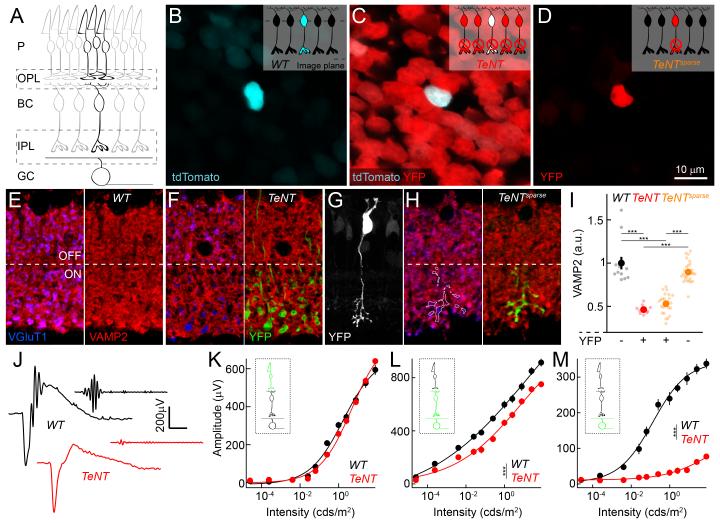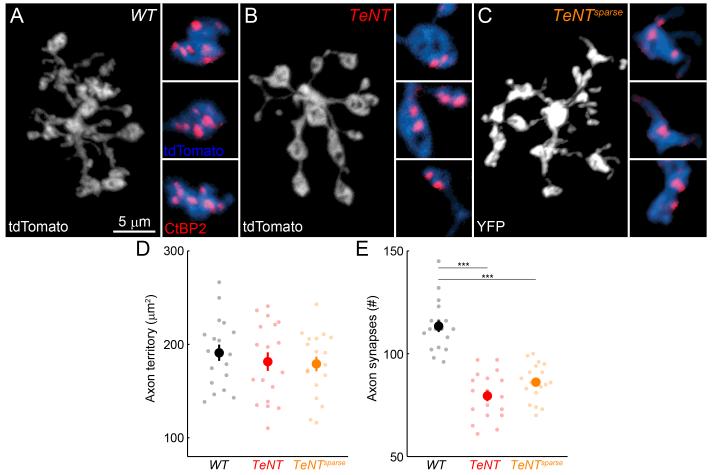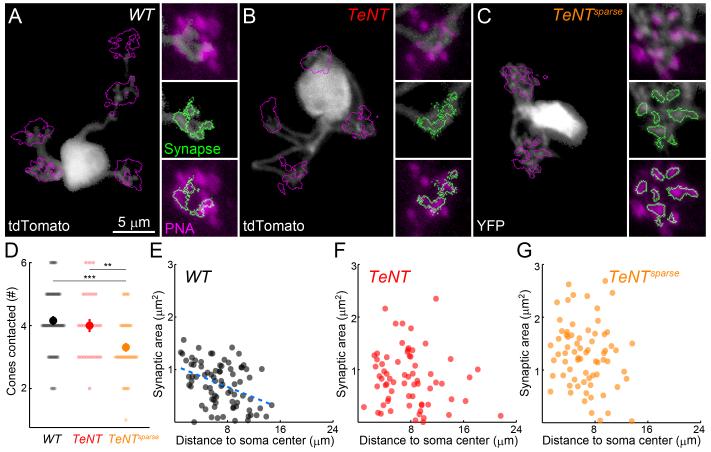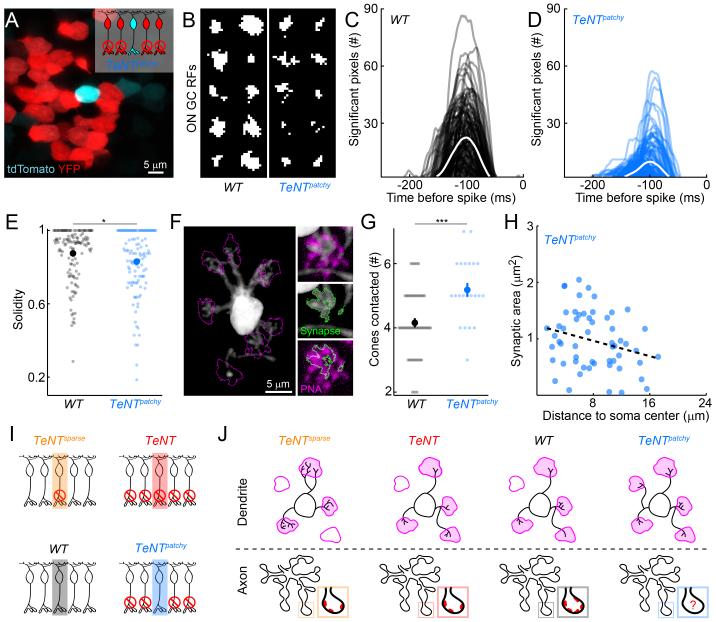Summary
Most neurons function in the context of pathways that process and propagate information through a series of stages, e.g. from the sensory periphery to cerebral cortex [1]. Because activity at each stage of a neural pathway depends on connectivity at the preceding one, we hypothesized that during development axonal output of a neuron may regulate synaptic development of its dendrites (i.e. retrograde plasticity). Within pathways, neurons often receive input from multiple partners and provide output to targets shared with other neurons (i.e. convergence) [2]. Converging axons can intermingle or occupy separate territories on target dendrites. Activity-dependent competition has been shown to bias target innervation by overlapping axons in several systems [3-8]. By contrast, whether territorial axons or dendrites compete for targets and inputs, respectively, has not been tested. Here, we generate transgenic mice in which glutamate release from specific sets of retinal bipolar cells (BCs) is suppressed. We find that dendrites of silenced BCs recruit fewer inputs when their neighbors are active and dendrites of active BCs recruit more inputs when their neighbors are silenced than either active or silenced BCs with equal neighbors. By contrast, axons of silenced BCs form fewer synapses with their targets, irrespective of the activity of their neighbors. These findings reveal that retrograde plasticity guides BC dendritic development in vivo and demonstrate that dendrites but not territorial axons in a convergent neural pathway engage in activity-dependent competition. We propose that at a population level retrograde plasticity serves to maximize functional representation of inputs.
Results and Discussion
BCs are glutamatergic second order neurons of the visual system, which receive input from photoreceptors (rods or cones) in the outer retina and innervate amacrine (ACs) and ganglion cells (GCs) in the inner retina (Figure 1A) [9]. There are 12 types of BCs in mice: 7 depolarize (ON BCs) and 5 hyperpolarize (OFF BCs) to light increments [9, 10]. Here, we analyze the influence of axonal activity on the development of type 6 ON BCs (B6s). Each B6 receives input from ~4 cones (Figure 2) [11] and ~200 of them converge onto a specific GC target [12, 13].
Figure 1.
Transgenic silencing of specific sets of bipolar cells in vivo.
(A) Schematic of the convergent vertical pathway through the retina. Several photoreceptors (P) synapse onto the dendrites of each bipolar cell (BC) in the outer plexiform layer (OPL). Axons of many BCs in turn innervate each ganglion cell (GC) in the inner plexiform layer (IPL).
(B-D) Images of BC somata in flat mounted retinas illustrate the expression patterns of tdTomato (cyan) and YFP (red, co-expressed with TeNT) in WT (B), TeNT (C) and TeNTsparse (D) mice. Inset schematics illustrate labeling (black: unlabeled, cyan: tdTomato, red: YFP, white: tdTomato and YFP) and activity status of the analyzed B6 cells (middle cell) and their neighbors. Red circles with diagonal crossings indicate axonal silencing by TeNT expression.
(E-H) Images of vibratome sections through the IPL of WT (E), TeNT (F) and TeNTsparse (G, H) retinas show VAMP2 depletion in axon terminals (VGluT1) of TeNT-expressing (i.e. YFP-positive) ON BCs. A zoomed-out view of an isolated YFP-positive B6 in a TeNTsparse retina is shown in (G). The left panel of (H) includes an outline of the perimeter of the masked axon terminal of the B6 shown in (G) and the right panel of (H).
(I) Quantification of the VAMP2 content of YFP-negative and YFP-positive ON BC axon terminals in WT (n = 12), TeNT (n = 10) and TeNTsparse (n = 26) retinas. Each small circle represents one retinal section and large circles (errorbars) denote population averages (± SEM).
(J) Raw (lower traces, horizontal scale bar: 50 ms) and high-pass filtered (cutoff: 100 Hz, upper traces, horizontal scale bar: 66 ms) ERG responses of dark-adapted WT (black) and TeNT (red) retinas to light flashes (2.526 cd s m−2).
(K-M) Population data (WT: n = 5 mice, TeNT: n = 5 mice) of a-wave (K), b-wave (L) and oscillatory potential (M) amplitudes. Insets highlight the cellular origins of the respective ERG components in the vertical pathway in green.
Figure 2.
Activity-dependent plasticity of BC axons.
(A-C) Projections through confocal image stacks of representative B6 axons in WT (A), TeNT (B) and TeNTsparse (C) retinas. Insets show single boutons of B6 axons and their CtBP2 labeling. (D, E) Comparisons of axonal territories (D) and synapse numbers (E) between WT (n = 18), TeNT (n = 18) and TeNTsparse (n = 19) retinas. Each small circle represents one cell. Large circles (errorbars) mark the population averages (± SEM).
See also Figure S1.
We previously developed mice in which a few B6s in each retina exhibit bright red fluorescence (Figure 1B, tdTomato), as well as mice in which all ON BCs express the light chain of tetanus toxin (Figure 1C, TeNT) and yellow fluorescent protein (YFP) [12, 14]. For this study, we generated additional transgenic lines expressing TeNT and YFP in a sparse subset of B6s (Figure 1D, TeNTsparse). TeNT inhibits transmitter release by cleaving vesicle-associated membrane protein 2 (VAMP2) [15]. Immunohistochemistry showed that VAMP2 is depleted similarly in YFP-positive axon terminals of TeNT and TeNTsparse mice and that YFP-negative ON BC axons in TeNTsparse retinas contain normal levels of VAMP2 (Figures 1E - 1I). We next compared electroretinographic (ERG) responses of wild-type (WT) and TeNT mice (Figure 1J). The preserved a-wave amplitudes of TeNT mice (Figure 1K) suggest that photoreceptor responses to light are unchanged. Oscillatory potentials and b-waves in the ERG arise in third order neurons (ACs and GCs) and BCs plus third order neurons, respectively [16]. Accordingly, we interpret the nearly complete suppression of oscillatory potentials (Figure 1M) accompanied by a small reduction in b-wave amplitudes (Figure 1L) in TeNT mice, as evidence that TeNT expression blocks glutamate release from BC axons in vivo, with no or only minor effects on signaling in BC dendrites. In vitro patch clamp and multielectrode array (MEA) recordings from GCs corroborate reduced transmitter release from BCs [14].
To analyze the role of transmitter release in the development of converging territorial axons, we compared arbor morphologies and synapse patterns of active B6 axons with active neighbors (WT), silenced B6 axons with silenced neighbors (TeNT) and silenced B6 axons with active neighbors (TeNTsparse). Individual B6s were visualized either by crossing to tdTomato mice (WT and TeNT) or by YFP expression in TeNTsparse mice. Axons of each BC type are strictly territorial and tile the retinal surface with few gaps and little overlap [10]. Confocal reconstructions revealed that B6 axons that are unable to release glutamate establish normal territories, even when surrounded by active neighbors (Figures 2A - 2D). Similarly, stratification patterns of B6 axons were indistinguishable between WT, TeNT and TeNTsparse mice (Figure S1), indicating that laminar targeting and territorial interactions of BC axons are independent of transmitter release. We next counted synapses, as identified by punctate labeling for C-terminal binding protein 2 (CtBP2) (Figures 2A - 2C), a component of presynaptic ribbons [17], which has been confirmed to appose postsynaptic specializations on GCs and ACs [12, 14, 18, 19]. We found that silenced B6 axons formed fewer synapses (Figure 2E); numbers were equally reduced in TeNT and TeNTsparse mice, suggesting that neurotransmitter release regulates target innervation by territorial axons without competition [20]. The difference in observations made of overlapping axons [3-8] suggests that the territorial arrangement of axons may serve to constrain the role of activity in synaptic development. We previously observed similar architectural boundaries to the influence of neurotransmission between axons targeting separate layers of bistratified dendrites [14].
To test whether neurotransmission retrogradely regulates dendritic development, we reconstructed B6 dendrites - and visualized their contacts with cone terminals by labeling with fluorescent peanut agglutinin (PNA) - in WT, TeNT and TeNTsparse mice (Figures 3A - 3C). Importantly, cone densities and terminal sizes were indistinguishable across genotypes (Figure S2). We found that dendrites of active and silenced B6s recruit similar numbers of cones so long as their neighbors are active or silenced as well (WT: 4.15 ± 0.14, n = 51, TeNT: 4.00 ± 0.21, n = 27, p > 0.5, Figure 3D and Figure S2). By contrast, silenced B6s with active neighbors contact fewer cones (TeNTsparse: 3.31 ± 0.14, n = 42, p < 0.0001 and p < 0.01 for comparisons to WT and TeNT, respectively, Figure 3D). These findings suggest that dendrites of neighboring B6s compete for input partners and that the outcome of their competitions is biased by retrograde signals elicited by axonal transmitter release. In WT retinas, the size of synapses on B6 dendrites decreases with distance from the soma (Figure 3E), as the likelihood of shared cone recruitment by neighboring B6s increases [10, 21]. The absence of this relationship in TeNT-expressing B6s (TeNT and TeNTsparse) further supports the idea that axonal transmitter release influences interactions between dendrites of neighboring BCs (Figures 3F and 3G).
Figure 3.
Retrograde activity-dependent plasticity of BC dendrites
(A-C) Projections through confocal image stacks of representative B6 dendrites in WT (A), TeNT (B) and TeNTsparse (C) retinas. Insets show individual contacts of B6 dendrites and cones stained with fluorescent peanut agglutinin (PNA). The perimeters of cones and synaptic contacts are outlined in magenta and green, respectively.
(D) Summary data comparing the numbers of cones contacted by B6s in WT (n = 51), TeNT (n = 27) and TeNTsparse (n = 42) retinas. Each small circle shows the number of cones contacted by one B6. Large circles (errorbars) represent the population averages (± SEM).
(E-G) Scatter plots of the area of synaptic contacts between cones and B6 dendrites as a function of distance from the center of the B6 soma. Each circle represents the contacts of one cone with a B6 dendrite (WT: 0.74 ± 0.05 μm2, n = 87, TeNT: 0.88 ± 0.07 μm2, n = 71, TeNTsparse: 1.31 ± 0.07 μm2, n = 72, p > 0.08 for WT vs. TeNT, p < 0.0001 for TeNTsparse vs. WT or TeNT). The dashed blue line in (E) indicates significant correlation in WT retinas (p < 0.001), which was not observed for TeNT-expressing B6s.
See also Figures S2 and S3.
Interestingly, the size of synapses between cones and B6s in TeNTsparse retinas was increased compared to WT and TeNT (p < 0.0001 for both comparisons, Figures 3E - 3G and Figure S3). We hypothesize that this increase in contact size is a consequence of the decrease in the number of cones contacted, indicative of homeostatic mechanisms that stabilize input to developing BCs. Similar observations of synaptic scaling have previously been made in other circuits [22-24].
If differences in axonal output of neighboring BCs indeed bias the outcome of their dendritic competitions, one would expect that active B6s with silenced neighbors expand dendritic territories and recruit additional cones. To test this prediction, we identified transgenic mice in which 18.5 ± 1.4 % of ON BCs express TeNT and YFP distributed in patches of high and low density (Figure 4A, TeNTpatchy). The patterns of VAMP2 depletion in TeNTpatchy retinas matched the patterns of YFP expression (Figure S4). Moreover, spatiotemporal receptive fields (RFs) of ON GCs measured in MEA recordings were smaller and spatially less homogeneous in TeNTpatchy compared to WT retinas, but showed preserved kinetics (Figures 4B - 4E), suggesting that TeNT-expressing ON BCs are silenced while the remaining ON BCs relay photoreceptor signals to GCs normally. Reconstructions of YFP-negative (i.e. active) B6s surrounded by YFP-positive (i.e. silenced) neighbors in high density patches (91.8 ± 6.4% YFP-positive ON BCs) of double transgenic TeNTpatchy tdTomato retinas (Figure 4A) revealed that their dendrites expand to contact more cones (WT: 4.15 ± 0.14, n = 51, TeNTpatchy: 5.18 ± 0.21, n = 22, p < 0.001, Figures 4F and 4G), whereas their axons occupy similar territories to WT B6s (WT: 191.02 ± 8.73 μm2, n = 18, TeNTpatchy: 186.25 ± 9.03 μm2, n = 19, p > 0.7). The size of cone-B6 contacts was on average slightly increased (p < 0.01) and their centroperipheral gradient across dendritic fields restored in TeNTpatchy retinas (Figure 4H). The former suggests that increased input (TeNTpatchy) during development does not trigger the same homeostatic adjustments as decreased input (TeNTsparse), while the latter reflects the influence of axonal activity on dendritic interactions.
Figure 4.
Dendrites of active BCs with silenced neighbors expand to recruit more cones.
(A) Image of BC somata in a flat mounted TeNTpatchy retina showing a single tdTomato-positive YFP-negative B6 surrounded by TeNT-expressing (YFP-positive) neighbors. Inset schematic illustrates labeling (cyan: tdTomato, red: YFP) and activity status of the analyzed B6 cells (middle cell) and their neighbors. Red circles with diagonal crossings indicate axonal silencing by TeNT expression.
(B) Binarized RF center maps of 10 representative ON GCs recorded in WT (left panel) and TeNTpatchy (right panel) retinas. Spike-triggered averages (STAs) were constructed from GC responses to 1 h of Gaussian checkerboard white noise stimulation. Significant center pixels were defined as having higher intensity (ON GCs) at the temporal peak of the response than expected based on simulated STAs constructed by random placement of a similar number of spikes as the cell in question (s. Experimental Procedures).
(C, D) Plots of the temporal evolution of the number of significant ON pixels (i.e. significantly higher intensity than mean) of ON GCs indicate reduced RF center size but preserved response kinetics in TeNTpatchy (D, n = 130) compared to WT (C, n = 134) and retinas.
(E) Comparison of the solidity of ON GC RFs in WT (n = 134) and TeNTpatchy (n = 130) retinas. Solidity was defined as the ratio of the area of the sum of the significant pixels over the area of the smallest convex polygon encompassing them. Each small circle represents one ON GC. Large circles (errorbars) mark the population averages (± SEM).
(F) Projection through a confocal image stack of representative B6 dendrites in a TeNTpatchy retina. Insets show individual contacts of the B6 dendrite with cones stained with fluorescent PNA. Perimeters of cones and synaptic contacts are outlined in magenta and green, respectively.
(G) Comparison of the numbers of cones contacted by B6s in WT (n = 51) and TeNTpatchy (n = 22). Each small circle shows the number of cones contacted by one B6. Large circles (errorbars) represent the population averages (± SEM). The increase in the number of cones contacted by B6s in TeNTpatchy retinas is mediated by an expansion of their dendritic territories (WT: 137 ± 10 μm2, n = 20, TeNTpatchy: 197 ± 14 μm2, n = 15, p < 0.002).
(H) Scatter plot of the area of cone-B6 synaptic contacts as a function of distance from the center of the B6 soma. Each circle represents the contacts of one cone with a B6 dendrite (WT: 0.74 ± 0.05 μm2, n = 87, TeNTpatchy: 0.96 ± 0.07 μm2, n = 56, p < 0.01). The dashed black line indicates significant correlation (p < 0.02).
(I) Schematic illustrating the activity status of the analyzed B6 cells (shaded areas) and their neighbors in TeNTsparse, TeNT, WT and TeNTpatchy mice. Red circles with diagonal crossings indicate axonal silencing by TeNT expression.
(J) Schematic summarizing the changes in bipolar development observed in TeNTsparse, TeNT, WT and TeNTpatchy mice. Changes in dendritic structure and connectivity with cones (magenta) are depicted in the top row, while effects on axonal morphology and the numbers of synapses (red) are illustrated in the bottom row.
See also Figure S4.
Together our results support the idea that dendrites of developing BCs compete for input partners and that the outcomes of dendritic competitions depend on transmitter release from axons of the same neurons (Figure 4I and 4J). By allocating inputs to developing dendrites of neighboring neurons according their axon’s ability to communicate information onwards, retrograde plasticity, at a population level, acts to maximize the functional representation of inputs (i.e. the coverage of inputs whose signals reach target layers). The signals that mediate retrograde influences on dendritic competitions, whether target-derived [25] or elicited by actions of glutamate on BCs themselves [26], remain to be identified. Interestingly, modifications of synaptic strength (LTP, LTD) have been shown to back propagate from the Xenopus tectum to the retina in a process dependent on BDNF signaling [27].
Unlike input recruitment on dendrites, absolute levels of transmitter release regulate synapse formation of BC axons rather than differences among neighbors and axon territories are established independent of activity (Figure 2, 4I and 4J). Converging territorial axons thus appear to follow different plasticity rules than axons that intermingle on target dendrites, due in part, likely, to their distinct spatial arrangements [14, 28]. Finally, our findings reveal that dendrites and axons of the same neurons can differentially engage in activity-dependent competitions in vivo, adding further complexity and precision to the known influences of activity on circuit development.
Supplementary Material
Highlights.
Neurotransmission regulates synaptogenesis of territorial axons non-competitively
Activity of BC axons regulates synaptic development of BC dendrites
Retrograde plasticity involves competition between dendrites of neighboring neurons
Retrograde plasticity may maximize functional input representation in neural pathways
Acknowledgments
We thank Drs. F. Soto, T. Holy, and P. Lukasiewicz for helpful comments on the manuscript and L. Zhao for excellent technical assistance. This research was made possible by support from the US National Institutes of Health (EY 023341, EY 021855), the Whitehall Foundation, Mallinckrodt Foundation, Sloan Foundation and the Research to Prevent Blindness Foundation to D.K. as well as the Vision Core Grant (EY002687) to the Department of Ophthalmology and Visual Sciences at Washington University School of Medicine.
Footnotes
Publisher's Disclaimer: This is a PDF file of an unedited manuscript that has been accepted for publication. As a service to our customers we are providing this early version of the manuscript. The manuscript will undergo copyediting, typesetting, and review of the resulting proof before it is published in its final citable form. Please note that during the production process errors may be discovered which could affect the content, and all legal disclaimers that apply to the journal pertain.
References
- 1.Felleman DJ, Van Essen DC. Distributed hierarchical processing in the primate cerebral cortex. Cerebral cortex. 1991;1:1–47. doi: 10.1093/cercor/1.1.1-a. [DOI] [PubMed] [Google Scholar]
- 2.Sanes JR, Zipursky SL. Design principles of insect and vertebrate visual systems. Neuron. 2010;66:15–36. doi: 10.1016/j.neuron.2010.01.018. [DOI] [PMC free article] [PubMed] [Google Scholar]
- 3.Antonini A, Fagiolini M, Stryker MP. Anatomical correlates of functional plasticity in mouse visual cortex. J Neurosci. 1999;19:4388–4406. doi: 10.1523/JNEUROSCI.19-11-04388.1999. [DOI] [PMC free article] [PubMed] [Google Scholar]
- 4.Ben Fredj N, Hammond S, Otsuna H, Chien CB, Burrone J, Meyer MP. Synaptic activity and activity-dependent competition regulates axon arbor maturation, growth arrest, and territory in the retinotectal projection. J Neurosci. 2010;30:10939–10951. doi: 10.1523/JNEUROSCI.1556-10.2010. [DOI] [PMC free article] [PubMed] [Google Scholar]
- 5.Buffelli M, Burgess RW, Feng G, Lobe CG, Lichtman JW, Sanes JR. Genetic evidence that relative synaptic efficacy biases the outcome of synaptic competition. Nature. 2003;424:430–434. doi: 10.1038/nature01844. [DOI] [PubMed] [Google Scholar]
- 6.Hua JY, Smear MC, Baier H, Smith SJ. Regulation of axon growth in vivo by activity-based competition. Nature. 2005;434:1022–1026. doi: 10.1038/nature03409. [DOI] [PubMed] [Google Scholar]
- 7.Yasuda M, Johnson-Venkatesh EM, Zhang H, Parent JM, Sutton MA, Umemori H. Multiple forms of activity-dependent competition refine hippocampal circuits in vivo. Neuron. 2011;70:1128–1142. doi: 10.1016/j.neuron.2011.04.027. [DOI] [PMC free article] [PubMed] [Google Scholar]
- 8.Yu CR, Power J, Barnea G, O’Donnell S, Brown HE, Osborne J, Axel R, Gogos JA. Spontaneous neural activity is required for the establishment and maintenance of the olfactory sensory map. Neuron. 2004;42:553–566. doi: 10.1016/s0896-6273(04)00224-7. [DOI] [PubMed] [Google Scholar]
- 9.Masland RH. The neuronal organization of the retina. Neuron. 2012;76:266–280. doi: 10.1016/j.neuron.2012.10.002. [DOI] [PMC free article] [PubMed] [Google Scholar]
- 10.Wassle H, Puller C, Muller F, Haverkamp S. Cone contacts, mosaics, and territories of bipolar cells in the mouse retina. J Neurosci. 2009;29:106–117. doi: 10.1523/JNEUROSCI.4442-08.2009. [DOI] [PMC free article] [PubMed] [Google Scholar]
- 11.Dunn FA, Wong RO. Diverse strategies engaged in establishing stereotypic wiring patterns among neurons sharing a common input at the visual system’s first synapse. J Neurosci. 2012;32:10306–10317. doi: 10.1523/JNEUROSCI.1581-12.2012. [DOI] [PMC free article] [PubMed] [Google Scholar]
- 12.Morgan JL, Soto F, Wong RO, Kerschensteiner D. Development of cell type-specific connectivity patterns of converging excitatory axons in the retina. Neuron. 2011;71:1014–1021. doi: 10.1016/j.neuron.2011.08.025. [DOI] [PMC free article] [PubMed] [Google Scholar]
- 13.Schwartz GW, Okawa H, Dunn FA, Morgan JL, Kerschensteiner D, Wong RO, Rieke F. The spatial structure of a nonlinear receptive field. Nat Neurosci. 2012;15:1572–1580. doi: 10.1038/nn.3225. [DOI] [PMC free article] [PubMed] [Google Scholar]
- 14.Kerschensteiner D, Morgan JL, Parker ED, Lewis RM, Wong RO. Neurotransmission selectively regulates synapse formation in parallel circuits in vivo. Nature. 2009;460:1016–1020. doi: 10.1038/nature08236. [DOI] [PMC free article] [PubMed] [Google Scholar]
- 15.Schiavo G, Benfenati F, Poulain B, Rossetto O, Polverino de Laureto P, DasGupta BR, Montecucco C. Tetanus and botulinum-B neurotoxins block neurotransmitter release by proteolytic cleavage of synaptobrevin. Nature. 1992;359:832–835. doi: 10.1038/359832a0. [DOI] [PubMed] [Google Scholar]
- 16.Wurziger K, Lichtenberger T, Hanitzsch R. On-bipolar cells and depolarising third-order neurons as the origin of the ERG-b-wave in the RCS rat. Vision Res. 2001;41:1091–1101. doi: 10.1016/s0042-6989(01)00026-8. [DOI] [PubMed] [Google Scholar]
- 17.Schmitz F, Konigstorfer A, Sudhof TC. RIBEYE, a component of synaptic ribbons: a protein’s journey through evolution provides insight into synaptic ribbon function. Neuron. 2000;28:857–872. doi: 10.1016/s0896-6273(00)00159-8. [DOI] [PubMed] [Google Scholar]
- 18.Jakobs TC, Koizumi A, Masland RH. The spatial distribution of glutamatergic inputs to dendrites of retinal ganglion cells. J Comp Neurol. 2008;510:221–236. doi: 10.1002/cne.21795. [DOI] [PMC free article] [PubMed] [Google Scholar]
- 19.Morgan JL, Schubert T, Wong RO. Developmental patterning of glutamatergic synapses onto retinal ganglion cells. Neural development. 2008;3:8. doi: 10.1186/1749-8104-3-8. [DOI] [PMC free article] [PubMed] [Google Scholar]
- 20.Okawa H, Della Santina L, Schwartz GW, Rieke F, Wong RO. Interplay of cell-autonomous and nonautonomous mechanisms tailors synaptic connectivity of converging axons in vivo. Neuron. 2014;82:125–137. doi: 10.1016/j.neuron.2014.02.016. [DOI] [PMC free article] [PubMed] [Google Scholar]
- 21.Keeley PW, Reese BE. Role of afferents in the differentiation of bipolar cells in the mouse retina. J Neurosci. 2010;30:1677–1685. doi: 10.1523/JNEUROSCI.5153-09.2010. [DOI] [PMC free article] [PubMed] [Google Scholar]
- 22.Burrone J, O’Byrne M, Murthy VN. Multiple forms of synaptic plasticity triggered by selective suppression of activity in individual neurons. Nature. 2002;420:414–418. doi: 10.1038/nature01242. [DOI] [PubMed] [Google Scholar]
- 23.Pozo K, Goda Y. Unraveling mechanisms of homeostatic synaptic plasticity. Neuron. 2010;66:337–351. doi: 10.1016/j.neuron.2010.04.028. [DOI] [PMC free article] [PubMed] [Google Scholar]
- 24.Turrigiano GG, Nelson SB. Homeostatic plasticity in the developing nervous system. Nat Rev Neurosci. 2004;5:97–107. doi: 10.1038/nrn1327. [DOI] [PubMed] [Google Scholar]
- 25.Harrington AW, Ginty DD. Long-distance retrograde neurotrophic factor signalling in neurons. Nat Rev Neurosci. 2013;14:177–187. doi: 10.1038/nrn3253. [DOI] [PubMed] [Google Scholar]
- 26.Pinheiro PS, Mulle C. Presynaptic glutamate receptors: physiological functions and mechanisms of action. Nat Rev Neurosci. 2008;9:423–436. doi: 10.1038/nrn2379. [DOI] [PubMed] [Google Scholar]
- 27.Du JL, Wei HP, Wang ZR, Wong ST, Poo MM. Long-range retrograde spread of LTP and LTD from optic tectum to retina. Proc Natl Acad Sci U S A. 2009;106:18890–18896. doi: 10.1073/pnas.0910659106. [DOI] [PMC free article] [PubMed] [Google Scholar]
- 28.Bleckert A, Wong RO. Identifying roles for neurotransmission in circuit assembly: insights gained from multiple model systems and experimental approaches. BioEssays: news and reviews in molecular, cellular and developmental biology. 2011;33:61–72. doi: 10.1002/bies.201000095. [DOI] [PMC free article] [PubMed] [Google Scholar]
Associated Data
This section collects any data citations, data availability statements, or supplementary materials included in this article.






